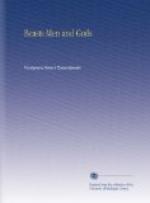It was from this custom, according to one explanation, that the town of Urga took its name among outsiders. By the Mongols themselves it is always referred to as Ta Kure, “The Great Monastery.” The reason the Buriats and Russians, who were the first to trade into this region, called it Urga was because it was the principal destination of all the trading expeditions which crossed the plains by this old method or right of travel. A second explanation is that the town lies in a “loop” whose sides are formed by three mountain ridges, along one of which the River Tola runs like the pole or stick of the familiar urga of the plains.
Thanks to this unique ticket of urga I crossed quite untraveled sections of Mongolia for about two hundred miles. It gave me the welcome opportunity to observe the fauna of this part of the country. I saw many huge herds of Mongolian antelopes running from five to six thousand, many groups of bighorns, wapiti and kabarga antelopes. Sometimes small herds of wild horses and wild asses flashed as a vision on the horizon.
In one place I observed a big colony of marmots. All over an area of several square miles their mounds were scattered with the holes leading down to their runways below, the dwellings of the marmot. In and out among these mounds the greyish-yellow or brown animals ran in all sizes up to half that of an average dog. They ran heavily and the skin on their fat bodies moved as though it were too big for them. The marmots are splendid prospectors, always digging deep ditches, throwing out on the surface all the stones. In many places I saw mounds the marmots had made from copper ore and farther north some from minerals containing wolfram and vanadium. Whenever the marmot is at the entrance of his hole, he sits up straight on his hind legs and looks like a bit of wood, a small stump or a stone. As soon as he spies a rider in the distance, he watches him with great curiosity and begins whistling sharply. This curiosity of the marmots is taken advantage of by the hunters, who sneak up to their holes flourishing streamers of cloth on the tips of long poles. The whole attention of the small animals is concentrated on this small flag and only the bullet that takes his life explains to him the reason for this previously unknown object.
I saw a very exciting picture as I passed through a marmot colony near the Orkhon River. There were thousands of holes here so that my Mongols had to use all their skill to keep the horses from breaking their legs in them. I noticed an eagle circling high overhead. All of a sudden he dropped like a stone to the top of a mound, where he sat motionless as a rock. The marmot in a few minutes ran out of his hole to a neighbor’s doorway. The eagle calmly jumped down from the top and with one wing closed the entrance to the hole. The rodent heard the noise, turned back and rushed to the attack, trying to break through to his hole where he had evidently




